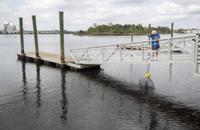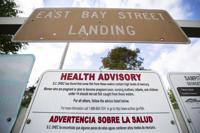GEORGETOWN — Industry is visible all along this historic city's waterways, including a paper plant and an on-again, off-again steel mill.
But less obvious is one of the more consequential sources of pollution here: Santee Cooper's Winyah Plant, a four-furnace coal-fired power station that sits in the middle of a wooded area just under 5 miles from downtown.
The plant, run by the state-owned utility, is one of three coal-fired stations that have not had updated water pollution permits for roughly a decade. The issue recently led to a lawsuit against the state's environmental regulator.
The station's stacks tower over the site's entrance off of Pennyroyal Road and the gypsum plant next door, pumping out billowing white steam when the furnaces are firing. It's capable of producing more than 1,100 megawatts of power but is running at lower levels these days as Santee Cooper plans to retire the four furnaces there in the next decade.

Santee Cooper’s Winya Generating Station operates in Georgetown on Wednesday, October 14, 2020. Lauren Petracca/Staff
Still, the news that the water pollution permits for the plant are out of date has raised alarm with many in this community who may be used to the area's industrial nature but now have additional worry about the cleanliness of the local water and the fish they pull from it.
"It was really mind blowing because we’re right here and there’s so much uncertainty," said LaToya Anderson, who lives in the Georgetown area. "It’s caused fear."
Anderson has fished on and off for the past eight years, often taking along her 14-year-old daughter Michaela Howard, and 4-year-old son, MiKendall Anderson, to fish for red brim and, if they were lucky, catfish. But since becoming involved with the Sierra Club earlier this year and learning about South Carolina's longstanding fish consumption advisories, she's put down her pole.
Most of the state's warnings are due to mercury in fish. Almost every stream the S.C. Department of Health and Environmental Control monitors in the state's coastal plain has a warning about at least one type of fish.
The Winyah plant has never recorded a mercury emission that violated Environmental Protection Agency limits, Santee Cooper spokeswoman Mollie Gore said. Still, coal-fired plants like Winyah produce contamination that ends up in local waters and fish.
The mercury problem
Mercury is a naturally occurring heavy metal and can enter the atmosphere in several ways — forest fires might release it, for example. But by far the biggest driver of the mercury contamination that's present globally today is burning coal, said Vijay Vulava, an associate professor at the College of Charleston who studies pollution.
The mercury that exits coal smoke stacks is vaporized, floating in the environment like steam. On dry days it stays aloft, and mercury can travel significant distances this way, even crossing state lines. But eventually it falls back down to the ground and makes its way into streams and rivers.
This is where the unique chemistry of rivers in the coastal plain make the problem worse, Vulava said.
Many rivers from the Midlands to the shore are "black" rivers — waterways dyed a dark tea color because of the organic matter decomposing inside them and on the bottoms. These bacteria-rich environments convert mercury into an organic compound — methylmercury — that's highly toxic to people.

Mary Ulias of Surfside Beach checks a crab trap at the East Bay Park boat landing in Georgetown on Wednesday, October 14, 2020. Lauren Petracca/Staff
This is the chemical that builds up in the fats of fish and later ends up on a dinner plate. In small doses, it leads to central nervous system problems and developmental issues, according to the EPA.
In concentrated doses, "coming into contact with it just through skin can kill an adult person in no amount of time," Vulava said.
Fish warnings
At the East Bay Park boat landing in Georgetown, DHEC has posted warnings about eating the local fish, as it has at many locations around the state.

Marilyn Hemingway, CEO and president of the Gullah Geechee Chamber of Commerce, poses for a portrait at the East Bay Park boat landing in Georgetown on Wednesday, October 14, 2020. As a young girl, Hemingway would fish at the landing, but stopped when advisory signs appeared warning of mercury contamination in fish. Lauren Petracca/Staff
Marilyn Hemingway remembers when the first fish consumption warnings went up in the park, known as "the Boulevard" by locals, around the time she was in middle school in the early 1980s. Hemingway is the president of the Gullah Geechee Chamber of Commerce, and grew up in the Maryville community of Georgetown. Her group has advocated for the sale of Santee Cooper.
After the warning signs showed up, she stopped crabbing at the scenic finger of land where the Sampit River empties into Winyah Bay.
Today, signs warn against eating largemouth bass more than once a week and bowfin more than once a month.
A separate sign warns pregnant women, soon-to-be pregnant women, nursing mothers and children under 14 "should not eat fish caught from these waters" because of high levels of mercury found in them.

A health advisory alerting of high mercury in fish is posted near the East Bay Street Landing, a popular spot for boating and fishing, in Georgetown on Wednesday, October 14, 2020. Lauren Petracca/Staff
DHEC has issued mercury-related warnings since the mid-1970s, and today tests the tissues of about 900 fish a year. Sixty-one waterbodies in South Carolina have an advisory on at least one species, urging people to eat only one meal a week, one meal a month or none at all.
The contamination is persistent; since 2007, only five waterbodies have had all their advisories removed.
There's even warnings for some fish caught in the Atlantic Ocean. King mackerel over 39 inches and shark should never be eaten because of mercury risk, DHEC says.
Mary Ulias, a retiree who lives near Surfside Beach, set out crab traps and a pole next to the boat landing on a recent Thursday afternoon. She said she's careful to check with DHEC over what species are safe to eat and is especially cautious after hurricanes and floods when contaminants may wash into local rivers.
William "Billy" Swails III, who works at the International Paper plant on the Sampit, was far less concerned as he docked after a trip on the water with his dad. He lives on the Black River in Williamsburg County and said he eats fish he personally catches about 10 times a month. Industry and facilities like the Winyah coal plant are just a part of life in town, he said.
"It's Georgetown. It's always been here," Swails said.
Hemingway, however, worries that anglers and others take the area's industrial nature and the pollution it brings for granted.
"They understand there is risk, but do they understand the full impact of it?" she said. "I don't think they do."
Plant retirement
At the Winyah Plant, Santee Cooper is already reducing the staff — workers there number 165, down from 190 at the beginning of 2020, utility spokeswoman Gore said. So far, the utility has been able to find new jobs elsewhere for these workers, and hopes to do the same for the remaining employees.
The plan is to shutter two of the plant's furnaces by 2023 and the remaining two by 2027. Some of the power generation will be replaced by solar, and some may be replaced by a "dual-fuel" unit that burns natural gas and diesel, Gore said.
DHEC did not comment on when it would have updated water pollution permits for the plant because of the ongoing lawsuit, filed by the Sierra Club. But Gore said it's unlikely any new permit or newly required pollution controls would change the timeline for closing.
For Hemingway, it's frustrating that DHEC, which is mandated with protecting both the state's environment and public health, hasn't acted to review the permits sooner. The agency has faced uncertainty in the last decade as the Obama administration made pollution standards tighter and then the Trump administration loosened them.
Still, Hemingway said, "people lose sight that there’s human beings down river."
Anderson, the woman who gave up fishing with her two children, said she's also concerned for family who live within a mile or two of the plant. She said the timeline for closing down should be faster.
Her worry also spreads to the remaining workers at Winyah.
"I hope they are able to transition to something else," Anderson said.
"fish" - Google News
October 19, 2020 at 06:03PM
https://ift.tt/3o5bB0X
Coal plant pollution has led to fish consumption warnings around SC - Charleston Post Courier
"fish" - Google News
https://ift.tt/35JkYuc
https://ift.tt/3feFffJ
Bagikan Berita Ini

















0 Response to "Coal plant pollution has led to fish consumption warnings around SC - Charleston Post Courier"
Post a Comment